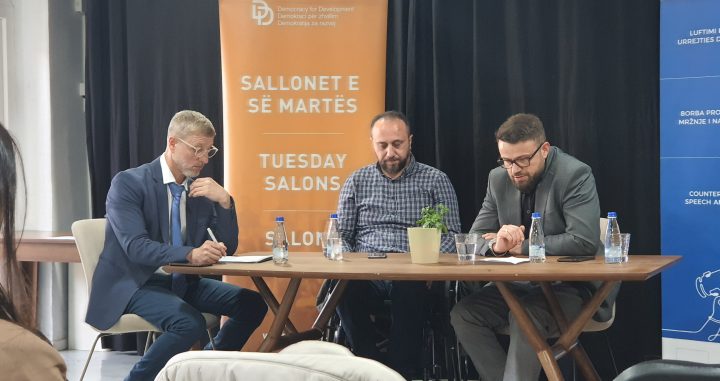
The use of offensive language in the media towards people with special needs and what measures should be taken as the topic we joined to discuss in the Tuesday salon held yesterday at the Center for Narrative Practice, Pristina. Invited to discuss from a professional perspective were: Afrim Maliqi, executive director at HANDIKOS, and Naim Telak, psychologist/AAB professor. Meanwhile, the salon was moderated by Ramadan Berisha, People in Need.
At the beginning of the discussion, Telaku said that when he understood the topic, it seemed quite a broad perspective, because the restrictive and discriminatory approach in the media is reflected by society itself. As an entry point, it considers the lack of genuine media representation of this group. Meanwhile, if we talk about artistic presentations such as in the form of films or satire, the behaviors of disabled people are hyperbolized. This definitely has its own consequences and reflects negatively on the well-being of persons with disabilities. According to Telak, if we have a great lack of information about mental health in the media, how will inclusiveness be encouraged with all the specifics it has? In the media, there is a tendency for labeling and stigmatization by not using the unified terminology, because there are still dilemmas and the adequate term has not been defined. This leads to the use of offensive language in Kosovo’s media, which is not very suitable for people with disabilities. Telaku, referring to the theory of social labeling, explains that when a person with a disability sees that others are seeing him as a special person, in this way it evokes a sense of inferiority and consequently they close in on themselves.
However, Maliqi thinks that the discussion would be good to focus on the correct use of terminology because according to him the media do not use offensive language, but they do not address people with disabilities in the right way. For this, their efforts as HANDIKOS have been in the publication of brochures where they have called for no other terminology to be used than that of persons with disabilities because the term and the way of approach are chosen by the persons themselves. If we happen to hear when the word category is often used thinking that they are referring to people with disabilities, this is not right. According to statistics, 15% of the population are persons with a disability. For example, when we talk about Down syndrome, it is not correct to say affected persons, but only a person with Down syndrome.
Maliqi also finds it disturbing that the media and journalists do not have basic knowledge about people with disabilities. So, as there are journalists who cover the field of economics, it would be appropriate to have journalists who are prepared to cover and report in the right way. Based on this, Maliqi says that they have signed a cooperation agreement with the KPM and have recommended the use of terms and the right approach to persons with disabilities in the media.
At the end of the discussion, the panelists agree that campaigns are not the way to raise public awareness of the correct use of terminology. Other appropriate ways must be found for people to start using a unified term for people with disabilities.
This publication was produced with the financial support of the European Union, within the project “Combating Discrimination, Hate Speech and Gender-Based Violence”. The content of this publication is the responsibility of ATRC, IKS and D4D and in no way, it cannot be considered as the position of the European Union.

